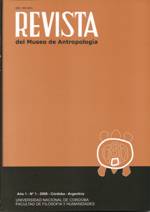«And we must be more united!»: Carnival and Policy in a rural region of the Quebrada de Humahuaca, or how to maintain the traditions that are lost in the town
DOI:
https://doi.org/10.31048/1852.4826.v1.n0.5395Keywords:
carnival, politics, performance, traditions- JujuyAbstract
Since some years ago, the academic reflections that from the Anthropology have been developed about diverse events of the social life, emphasize the performatic dimension of certain dramatic genres, as the cases of rituals and parties. In the frame of the ethnographic field works carried out during the summer of 2008, we had the opportunity to take part in the different events that shape the carnival that every year is feasted in the gorge of Pipintu Grande, Jujuy. Immersed in the festive climate of the carnival, trying to take the pulse of the rituals of the ‘entierro’ and the ‘desentierro’, so prolific of couplets of unusual ingenuity as in ‘ch’allas’ and ‘machas’, we began to think about the manners of articulation between the performatic genres, the identities and the processes of resistance, that are modulated around a tension between the perception of an agonistic development that threatens the interfamiliar union, threat represented in the politics, and the putting in act of ‘traditional’ symbolic elements, where the fear to the loss of the traditions and customs articulates the speeches that are unfold during the carnival.Downloads
References
Alberti, G., E. Mayer 1974. Reciprocidad andina: ayer y hoy. Giorgio Alberti y Enrique Mayer (compiladores). Reciprocidad e intercambio en los Andes peruanos. Perú Problema 12. Presentación Pp. 13-34. Instituto de Estudios Peruanos, Lima.
Appadurai, A. 2001. La producción de lo local. La modernidad desbordada. Dimensiones culturales de la globalización. Pp. 187-207. Ediciones Trilce/ FCE, Buenos Aires.
Bajtín, M. 1994. La cultura popular en la Edad Media y en el Renacimiento. El contexto de François Rabelais. Alianza Editorial, Buenos Aires.
Costa, M., G. Karasik 1996. ¿Supay o Diablo? El Carnaval en la Quebrada de Humahuaca (Provincia de Jujuy, Argentina). Bernd Schmelz y N. Ross Crumrine (eds.) Estudios sobre el sincretismo en América central y los Andes. Pp. 275-304. Holos/ Estudios Americanistas de Bonn, Bonn.
Da Matta, R. 1981. Carnavais, malandros e heróis. Para uma sociologia do dilema brasileiro. Zahar Editores, Rio de Janeiro. Eco, U. 1998 ¡Carnaval! Fondo de Cultura Económica, México.
Gordillo, G. 2006. En el Gran Chaco. Antropologías e historias. Prometeo, Buenos Aires.
Guber, R. 2005. El salvaje metropolitano. Reconstrucción del conocimiento social en el trabajo de campo. Paidós. Estudios de comunicación, Buenos Aires.
Harvey, D. 1996. Justice, Nature, and the Geography of Difference. Blackwell, Oxford.
Isla, A. 2002. Los usos políticos de la identidad. Indigenismo y Estado. Editorial de las Ciencias. Buenos Aires.
Karasik , G. 2005. «Etnicidad, cultura y clases sociales. Procesos de formación histórica de la conciencia colectiva en Jujuy, 1985-2003». Facultad de Filosofía y Letras, Universidad Nacional de Tucumán, Argentina, 357 páginas. Biblioteca de la Facultad de Filosofía y Letras de la Universidad Nacional de Tucumán.
Lefevre, H. 1991 [1974]. The production of Space. Blackwell, Oxford.
Malinowski, B. 1986 [1926]. Crimen y costumbre en la sociedad salvaje. Planeta Agostini. Barcelona.
Menelli, Y. 2007. «Un abordaje de la performance de contrapunto de coplas «hombre» y «mujer» en el carnaval humahuaqueño». Escuela de Antropología, Facultad de Humanidades y Artes, Universidad Nacional de Rosario, Argentina, 224 páginas. Biblioteca de la Facultad de Humanidades y Artes de la Universidad Nacional de Rosario.
Merlino, R., M. Rabey 1992. Resistencia y hegemonía: cultos locales y religión centralizada en los Andes del sur. Allpanchis N° 40: 173-200, Cuzco.
Myerhof, B., S. Moore. 1977. Secular Ritual. Myerhof, Barbara & Sally Moore (Edit.). Van Gorcum Assen, Amsterdam.
Palmeira, M. 1992. Voto: Racionalidade ou significado? Revista Brasilera de Ciências sociais N° 20 Ano 7: 26-30.
Palmeira, M., B. Heredia 1993. Le temps de la politique. Études rurales N° 131-132 juilletdécembre : 73-87.
Prieto, A. 2007. Los estudios de performance: una propuesta de simulacro crítico. Cuadernos de investigación teatral N°1: 52-61 http://performancelogia.blogspot.com/2007/07/losestudios-del-performance-una.html (última consulta 20/10/2008).
Turner, V. 1966. La selva de los símbolos. Aspectos del ritual ndembu. Siglo XXI, Madrid.
Turner, V.1975. Dramas, Fields and Metaphors. Symbolic action in human society. Cornell University Press. Ithaca and London.
Downloads
Published
Issue
Section
License
Those authors who have publications with this Journalaccept the following terms:
a. Authors will retain their copyrights and guarantee the journal the right of first publication of their work, which will be simultaneously subject to the Creative Commons Attribution License (Licencia de reconocimiento de Creative Commons) that allows third parties to share the work as long as its author and his first publication in this journal.
b. Authors may adopt other non-exclusive licensing agreements for the distribution of the version of the published work (eg, deposit it in an institutional electronic file or publish it in a monographic volume) provided that the initial publication in this journal is indicated.
c. Authors are allowed and recommended to disseminate their work on the Internet (eg in institutional telematic archives or on their website) before and during the submission process, which can lead to interesting exchanges and increase citations of the published work. (See The Effect of Open Access - El efecto del acceso abierto)












